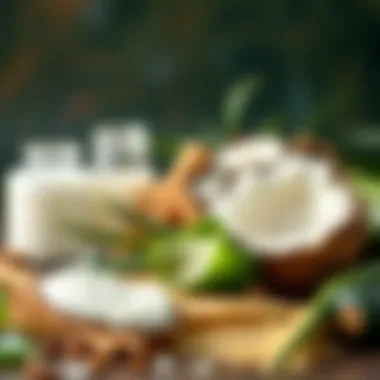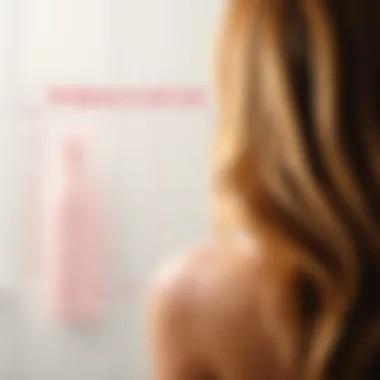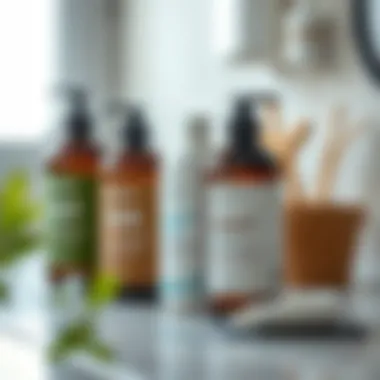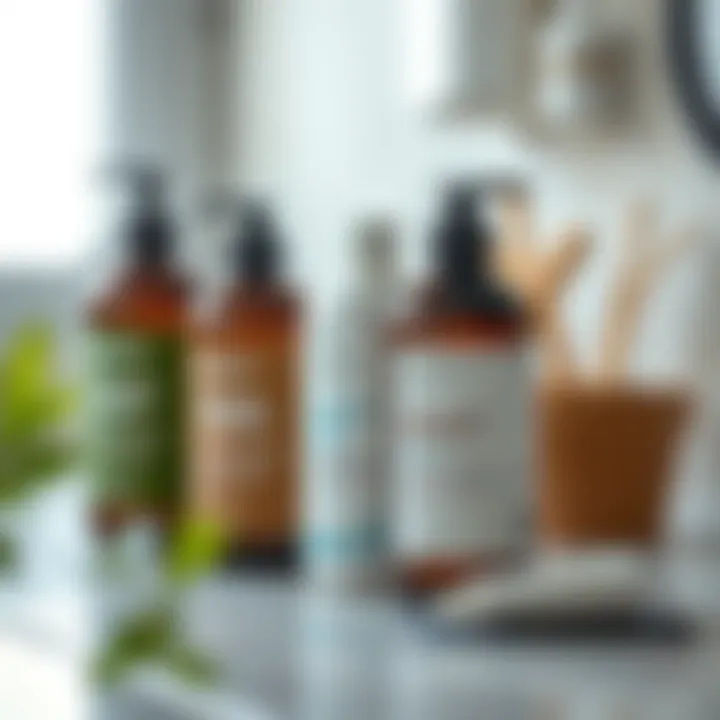The Healthiest Shampoo and Conditioner Guide


Intro
Maintaining healthy hair can often feel like wandering through a maze, especially with the plethora of products lining the shelves. The world of shampoos and conditioners is not just about lathering up and rinsing off; it's a nuanced interplay of ingredients, formulations, and personal preferences. What works wonders for one person may well leave another's hair looking like an aftermath of a bad storm. So, how does one navigate through the incessant noise of marketing and find products that genuinely cater to their unique hair needs?
In this guide, we dive deeper than surface-level marketing claims. We will dissect ingredients that nourish and protect, explore the significance of pH levels, and address how different hair types—from wavy to straight, thin to thick—require tailored approaches. Furthermore, with a growing shift toward eco-consciousness in the beauty industry, understanding sustainable practices in product selection is more crucial than ever.
So, whether you're someone who prefers natural remedies, a beauty enthusiast, or simply hunting for that perfect product to tame your tresses, you're in the right spot. We will equip you with the knowledge you need to make informed choices about the healthiest shampoos and conditioners out there.
Key Trends
With a keen rise in awareness about healthy living, the beauty industry is shifting towards cleaner and greener options. Here’s what’s trending right now in hair care:
- Natural Ingredients: Ingredients like aloe vera, coconut oil, and shea butter are now more popular than ever. Not only do they provide nourishment, but many also offer additional benefits like hydration and anti-inflammatory properties.
- Sulfate-Free Formulations: More people are opting for sulfate-free shampoos as they’re gentler on the hair and scalp. These shampoos help maintain the natural oils and moisture, preventing dryness and damage.
"Health-conscious consumers are becoming increasingly aware of what they apply to their bodies, including their hair."
- Personalized Hair Care: The emergence of brands offering customizable shampoos and conditioners based on individual hair testing is making waves. With this trend, consumers can have products tailored just for them.
- Eco-friendly Packaging: An uptick in sustainable practices means more companies are choosing to minimize plastic waste with biodegradable packaging or refillable options. Look for brands that take sustainability seriously to make an impact.
The trends reflect a broader consciousness about health and well-being. As consumers become savvier, product offerings must align with their values and skincare needs. Understanding these key trends can help you make choices that are not just better for you, but also for the planet.
Preface to Hair Care
Hair often serves as a person’s crowning glory and can be a key element of one’s self-expression. In this article, we’ll delve into the importance of understanding hair care, especially focusing on selecting the right shampoo and conditioner. Choosing appropriate hair products is not merely a ritual but a crucial factor in maintaining healthy hair and scalp. Your locks endure daily stress from environmental factors, styling tools, and products, making the right choice of shampoo and conditioner not just important but necessary.
Importance of Choosing the Right Products
When it comes to hair care, the products we use can make or break our hair health journey. The right shampoo and conditioner not only clean but also nourish and protect. Think of it this way — you wouldn’t use a sledgehammer to push in a thumbtack, right? So why would you use harsh sulfates and chemicals on your delicate strands?
Selecting products that suit your unique hair type and needs helps ensure that your hair remains vibrant and manageable.
Here’s a look at some reasons why choosing the right products is essential:
- Maintaining Healthy Hair: Each hair type has its specific needs, and using the wrong product can lead to dryness, breakage, and even scalp irritation.
- Enhancing Appearance: Quality products can enhance the natural shine and texture of your hair, making it look healthier and more lively.
- Avoiding Long-term Damage: Investing in good quality hair products can prevent long-term damage and costly remedies later on.
Impact of Hair Products on Health
The products we slather on our hair don’t just affect the visible strands; they penetrate deeper, affecting our scalp and, ultimately, our overall health. Many mainstream hair products contain chemicals that may lead to unintended consequences. Parabens, sulfates, and artificial fragrances can be harmful, often triggering allergic reactions or irritations.
Moreover, studies have shown that some hair care ingredients can disrupt hormonal balance and lead to several health concerns over prolonged use. For example, phosphates and other synthetic compounds can aggravate sensitivity in individuals with skin conditions.
To put it simply, we live in a world where our choices matter, and the shampoos and conditioners we select can have a ripple effect on our well-being. Choosing safer, more natural alternatives can lead not only to healthier hair but also to better overall health.
"The products we use can be a reflection of who we are, making a choice for health conscious beauty more than just aesthetics."
In summary, hair care choices are not to be taken lightly, as they hold significant weight in our hair’s lifecycle and our overall health. As we continue in this comprehensive guide, we will analyze the ingredients, formulations, and more, guiding you to make informed decisions that resonate with your hair health goals.
Understanding Ingredients
When it comes to selecting hair care products, the significance of understanding ingredients cannot be overstated. The right combination of substances makes all the difference in whether your hair flourishes or flounders. It’s the fabric of your hair’s health and vitality. Ingredients can either enhance your hair's natural texture or exacerbate underlying issues—from dryness to excessive oiliness. Therefore, knowing what goes into your shampoo and conditioner is crucial.
Natural vs. Synthetic Ingredients
Natural ingredients are derived from plants. They tend to be gentle on the hair and scalp, often offering nourishing benefits without the harsh side effects. Examples include coconut oil, shea butter, and botanical extracts. Synthetic ingredients, on the other hand, are man-made and can be effective in producing immediate results. However, they may contain preservatives or other chemicals that might irritate your hair or scalp over time.
In a world where health consciousness reigns supreme, opting for organic ingredients can lead to not just healthier hair, but also a healthier environment. Brands focusing on natural ingredients often emphasize the absence of parabens and sulfates, making them appealing for those looking to avoid potential pitfalls.
Common Harmful Chemicals to Avoid
Navigating through product labels can feel like running a gauntlet. Certain chemicals are known troublemakers. Here are a few to watch out for:


- Sulfates: These can strip your hair of its natural oils, causing dryness and frizz.
- Parabens: Used as preservatives, they have been linked to hormonal disruptions.
- Formaldehyde and its derivatives: Known irritants that could lead you down a path of scalp sensitivity.
Being savvy about what goes on your hair is the first step toward making informed choices for both style and health.
Beneficial Ingredients for Hair Health
If you’re looking to bolster your hair health, certain ingredients stand out for their advantages and efficacy. Let’s dive deeper into four of these stars:
Keratin
Keratin is a fibrous protein that is the cornerstone of hair structure. It fills in gaps in the hair's cuticle layer and glosses over any damaged areas. This not only enhances shine, but also adds strength to the strands, making it a popular choice for people seeking smoother and more resilient hair. The unique feature of keratin lies in its capacity to bond with the hair, helping it combat wear-and-tear effectively. However, overuse can lead to buildup, so moderation is key.
Argan Oil
Argan oil has taken the beauty industry by storm, and for good reason. Extracted from the nuts of the argan tree, it is rich in essential fatty acids and vitamin E. The key characteristic of argan oil is its deep moisturizing properties. This makes it an ideal teammate for repairing and hydrating dry or brittle hair. However, a little goes a long way; too much can create a greasy appearance, which might dampen its benefits.
Essential Oils
Essential oils are not just for aromatherapy. Their benefits can cross over into hair care, offering various advantages based on the type used. Lavender oil, for instance, promotes relaxation and may encourage hair growth. Peppermint oil, with its invigorating scent, can stimulate the scalp and enhance circulation. The unique feature of essential oils is their versatility, which allows them to target multiple hair concerns. But always be sure to mix them with a carrier oil to avoid any scalp irritation.
Aloe Vera
Aloe vera is often touted as a miracle plant in the realm of beauty. Its gel-like texture has soothing properties, making it suitable for all hair types. The key characteristic of aloe vera is its ability to restore moisture while also promoting scalp health. In an industry crowded with products that often dry out the scalp, aloe steps in as a restorative hero. Despite its many virtues, some may experience allergic reactions, so testing a small patch before applying is advisable.
Different Hair Types and Their Needs
Understanding different types of hair is crucial when selecting the healthiest shampoo and conditioner. Each hair type has unique characteristics and needs, which influence how the hair responds to products. By tailoring your choice of products, you can optimize their effectiveness and maintain overall hair health.
Understanding Your Hair Type
Straight
Straight hair tends to lie flat and follows the head's natural shape. It generally has a smooth surface, which allows oils produced by the scalp to distribute easily down the hair shaft. This quality often makes straight hair appear shinier and more manageable. Nevertheless, some individuals with straight hair face challenges like oil build-up or lack of volume. To benefit from a shampoo and conditioner that caters to this type, look for formulas that enhance texture or volumize, helping maintain a balanced appearance without overly stripping natural oils.
Wavy
Wavy hair is the best of both worlds. It's not completely straight and not tightly curled. The natural waves can range from loose to well-defined, providing body and texture while also being susceptible to frizz if not cared for properly. One unique feature of wavy hair is its resilience; it can often manage styles with less effort than other types. Selecting products that promote hydration is important for wavy hair, as they help to keep the curls defined without weighing them down. Look for moisturizing shampoos and conditioners enriched with essential oils.
Curly
Curly hair can be both a blessing and a challenge. Characterized by its distinct coils or ringlets, it tends to be drier compared to other types due to the difficulty in the natural oils from the scalp traveling down the curly strands. This type requires substantial moisture and weightlessness to thrive. Curly hair is popular among individuals looking for a bold and unique style. On the downside, it can be frizzy without the right products. Opt for sulfate-free shampoos and rich, creamy conditioners that repair and hydrate each curl while maintaining their form.
Kinky
Kinky hair is highly textured, characterized by tight curls or zig-zag shapes. This type is often the most fragile and is susceptible to breakage. Kinky hair typically requires a considerable amount of moisture and protection. Its unique characteristic of shrinkage can make it appear shorter than its actual length, but this type showcases a distinct beauty all its own. For individuals with kinky hair, it's essential to use shampoos that cleanse gently without stripping oils and conditioners that provide deep hydration and strengthening properties. Look for products containing shea butter or other similar ingredients that nourish and protect.
Tailoring Products to Hair Needs
When it comes to hair care, understanding your hair type is just the beginning. Tailoring products to meet specific needs can significantly enhance the effectiveness of your hair routine. Whether your hair is dry, oily, or somewhere in between, choosing the right formulations ensures healthier, more manageable locks.
Scalp Health Considerations
The health of your scalp is just as important as the hair itself. Addressing issues related to scalp health can lead to improved hair quality. Each scalp has distinct needs, and recognizing these can make a world of difference in your hair care routine.
Oily Scalp
An oily scalp produces excess sebum, which can lead to greasy hair and potential scalp issues if not managed. Oily hair often requires a balancing shampoo that cleanses thoroughly while not overly drying out the scalp. Look for formulations that contain tea tree oil or charcoal, as these ingredients can help absorb excess oil and provide a refreshing clean.


Dry Scalp
A dry scalp can cause irritation and flaking, making it essential to use products designed to hydrate and soothe. Shampoos and conditioners with moisturizing ingredients like aloe vera or coconut oil can be beneficial. These ingredients help to restore moisture balance and reduce itchiness associated with dryness, providing a more comfortable experience.
Sensitive Scalp
For individuals with a sensitive scalp, irritants found in common hair products can lead to discomfort or allergic reactions. Choosing gentle, hypoallergenic formulations is vital. Look for products that are free of sulfates, parabens, and strong fragrances to minimize the risk of irritation. Natural plant-based ingredients can also help soothe the scalp, making it easier to discover the right fit for your hair care routine.
Eco-Friendly and Sustainable Choices
In a world increasingly aware of its environmental footprint, the conversation around hair care is shifting toward more sustainable practices. Choosing eco-friendly and sustainable shampoo and conditioner is not just a trend; it is a way to align personal care habits with a commitment to the planet. These choices promote health, not just for our hair, but for our environment, as they often avoid harsh chemicals and synthetic ingredients that can harm ecosystems. By making mindful decisions in our hair care routines, we can contribute to broader sustainability efforts.
The Rise of Eco-Conscious Brands
More brands are cropping up that prioritize environmental responsibility. Companies are now creating products with ingredients sourced sustainably and often employing methods that minimize carbon footprints during production. For instance, brands like Ethique and Lush focus on solid shampoo bars that cut down on plastic waste. The rise of these eco-conscious brands illustrates a significant change in consumer preferences. Today’s shoppers are more likely to support businesses that reflect their values and commitment to environmental conservation. This shift not only supports local communities but also nurtures a sustainable economy.
Packaging and Environmental Impact
A crucial aspect often overlooked is the packaging of hair products. Traditional plastic bottles contribute enormously to landfill waste, taking hundreds of years to decompose. In contrast, many eco-friendly brands use recyclable or compostable packaging. Some companies are even taking it a step further by implementing refill stations, encouraging customers to bring their own containers. This trend towards sustainable packaging not only reduces waste but also promotes a circular economy, where products are reused and recycled rather than discarded.
Certification and Labeling to Look For
Understanding labels can be a daunting task amid marketing jargon. Knowing what certifications to look for can empower consumers to make informed choices:
Cruelty-Free
Cruelty-Free products are those that have not been tested on animals. This practice is widely seen as a more ethical option, appealing to consumers who are concerned about animal welfare. A key characteristic of Cruelty-Free products is that they often undergo rigorous testing that excludes animal testing altogether. Many consumers gravitate towards these products, as they align with humane values. However, it’s essential to note that "Cruelty-Free" does not always guarantee that a product is free from synthetic chemicals or environmentally friendly practices.
Organic
Organic products are made from ingredients grown without synthetic pesticides or fertilizers. This choice is increasingly popular for those seeking a more natural hair care regimen. The unique feature of organic shampoos and conditioners lies in their minimal processing, allowing consumers to benefit from the concentrated nutrients found in natural sources. While organic options can be more expensive, the investment often pays off in terms of healthier hair and a reduction in harmful pollutants entering our waterways.
Vegan
Vegan products are free from all animal-derived ingredients, making them a favorite among health-conscious and ethical consumers. The key aspect of vegan hair care is that it often avoids harsh chemicals and focuses on plant-based ingredients. While the blend of natural components can offer remarkable benefits, it’s crucial to check that vegan options are also cruelty-free and sustainably sourced. This added layer ensures that not only is the individual’s hair cared for sustainably, but the approach aligns with broader ethical choices.
Product Formulations and Their Effects
Understanding product formulations is essential for making informed choices about shampoos and conditioners. Each formulation has a distinct role in the overall health of hair, and recognizing what works for your hair type and condition will lead you closer to achieving your hair goals. When it comes to hair care, it’s not merely about cleaning or conditioning; it’s about addressing specific needs that can vary from one person to another. Factors such as ingredients, consistency, and targeted benefits all play significant roles.
Shampoo Types and Their Functions
Sulfate-Free
Sulfate-free shampoos have gained popularity for their gentler formulas. The importance of these products lies in their ability to cleanse without stripping natural oils, which keeps the hair moisture intact. One characteristic that sets sulfate-free shampoos apart is that they typically use alternative cleansers derived from natural sources, minimizing irritation for those with sensitive scalps. While they may not foam as much as traditional shampoos, they do the job without leaving hair feeling dry or brittle. However, some users may find they need to wash their hair more frequently due to the milder cleansing properties, which could be viewed as a drawback.
Clarifying
Clarifying shampoos serve a different purpose. They are designed to remove buildup from hair products, minerals from water, and even excess oil. What makes these shampoos distinct is their strength; they often contain stronger surfactants to thoroughly cleanse. As a result, they can bring back that fresh, vibrant look to hair and allow other products to perform better. A potential disadvantage, though, is that they can be overly drying if used too frequently, particularly on colored or chemically treated hair. Therefore, it's crucial to use them responsibly and probably reserve them for occasional use.
Moisturizing
Moisturizing shampoos focus on hydration, ideal for those with dry and brittle hair. They contain ingredients such as natural oils and humectants, which lock moisture and soften hair. The key characteristic of these formulations is their creamy texture, which helps nourish hair while cleaning. For individuals living in dry climates or those frequently using heating tools, these shampoos can become a staple. However, they may weigh down fine hair and result in excess grease if not paired with appropriate conditioning treatments.
Conditioner Varieties to Consider
Leave-in


Leave-in conditioners offer a great option for ongoing nourishment as they remain in the hair post-wash. This type of product is particularly beneficial for people with textured or curly hair, as it helps manage frizz and enhance curl definition. The convenience of leave-in conditioners lies in their ease of use; you simply apply it to damp hair and go. However, one trade-off is that if overused, they might lead to product buildup, requiring occasional deep-cleansing.
Deep Conditioning
Deep conditioning treatments are designed for those who need intense hydration and repair. Typically richer in formulations, they penetrate deeply into the hair shaft to mend damage and enhance strength. An essential feature is the extended time they often require on the hair to achieve maximum benefit. This treatment is excellent for recovering from over-processing or environmental stressors. However, these products can sometimes feel oily if not washed out thoroughly, leaving hair feeling heavy.
Daily Conditioner
Daily conditioners are made for straightforward, everyday use. They provide a balance of moisture and light detangling properties without overwhelming the hair. The beauty of a daily conditioner is its simplicity; it can rejuvenate your hair after each wash. For those with healthy hair, this could be all you need. But, if your hair is particularly damaged or dry, you might want to integrate more intensive treatments into your routine as well.
Ultimately, understanding product formulations can help optimize your hair care routine, tailoring it to your unique needs.
User Suggestions and Preferences
Finding the perfect shampoo and conditioner can feel like searching for a needle in a haystack, especially with the vast choices flooding the market. In this segment, we will dive into the essence of user feedback and preferences. Individuals are often eager to share experiences with various products, and this collective wisdom can guide others toward making healthier choices for their hair.
How to Choose Products Based on Reviews
When it comes to selecting hair care products, the reviews tell stories that go beyond the flashy advertisements. Customer feedback is invaluable, providing insights into how specific shampoos and conditioners perform in the real world. Here's how to navigate these reviews effectively:
- Look for Consistency: Check if multiple users report similar outcomes with a product. If everyone raves about the moisturizing properties of a specific conditioner, it’s likely worth considering.
- Consider Hair Types: Not all reviews are created equal. Pay attention to those with hair types similar to yours. For example, a product touted for curly hair may not work the same for straight locks.
- Note the Date: Hair care formulations can change. Old reviews may refer to a different formula. Make sure to focus on recent feedback.
Utilizing platforms like Reddit or beauty forums can provide a treasure trove of honest opinions, often featuring everyday consumers rather than sponsored echoes.
Factors Influencing User Experience
User experiences hinge on many diverse elements, which must be considered as you sift through your options. Individual preferences, hair types, and even environmental factors can dramatically alter perceptions of a product:
- Ingredients Sensitivity: Some people may experience adverse reactions to particular components. Reading user reviews can unveil trends in reactions to ingredients like sulfates or artificial fragrances.
- Functionality: Consider how the product works with your routine. Some may find a leave-in conditioner cumbersome while others swear by it. Is the scent pleasant? Does it wash out easily?
These specifications can make all the difference as you assess what aligns with your needs.
Trial and Error in Finding the Right Fit
Embarking on a quest for the ideal shampoo and conditioner is rarely a straightforward path—it’s more of a winding road filled with trials and errors. Accepting that this process often involves testing a few products can help manage expectations:
- Sample Sizes: Opt for travel-sized versions before committing to full-sized bottles. Many brands like SheaMoisture or Bumble and bumble offer these options, letting you test the waters without making a splash.
- Track Changes: Keep a hair journal detailing what you use and how your hair reacts. This record will be helpful in identifying patterns over time.
- Join Conversations: Engage in forums or community discussions on platforms like Facebook and Reddit, gathering insights that can inform your experiments. Others may reveal hidden gems that resonate with your specific requirements.
Overall, openness to trial and error is key. It allows you to honor your hair's unique needs while also navigating the myriad of choices available. In this intricate dance of preference and suggestion, finding a product that makes you feel confident about your hair is the end goal.
Closure: Making Informed Choices
Making informed choices about hair care products is paramount in today's market saturated with options. The quest for the healthiest shampoo and conditioner isn't just about achieving a lustrous mane; it's about understanding the ingredients, benefits, and impact those products have on your overall health. This article has delved deep into the essentials of hair care, identifying key factors that influence product selection.
Knowing your hair type and its needs is just the tip of the iceberg. Ingredients matter significantly. It’s easy to get caught up in marketing buzzwords, but a closer look reveals the true nature of what you’re applying to your scalp and strands. Choosing products that are free from harmful chemicals like sulfates, parabens, and synthetic fragrances can mitigate the risk of irritation and long-term damage. Moreover, considering organic and sustainable options shows an investment not only in your hair but also in the planet's health.
Understanding how ingredients work together to provide benefits like hydration, repair, and protection aids greatly in selecting the right products. By paying attention to both the formulation and personal concerns, users can ensure their choices lead to healthier hair over time.
"Choosing wisely influences not just the way your hair looks, but also how you feel about your personal care routine."
Summarizing Key Points
To wrap things up, let’s review several key takeaways from our exploration:
- Ingredients are vital: Always read labels to discern what is in your hair care products. Look for beneficial components and avoid harmful additives.
- Tailored solutions are crucial: Match products to your specific hair needs, whether it’s moisture for dry hair or balancing oil for an oily scalp.
- Eco-consciousness matters: Don’t just focus on your hair; think about the environmental impact of your choices. Opt for brands that prioritize sustainability.
- User experience is variable: Remember that what works for one may not work for another. Experiment within healthy boundaries to find the fit that suits you best.
Encouragement for Sustainable Practices
As we navigate through an era that increasingly calls for sustainability, it's essential to integrate eco-friendly practices into our beauty routines. When selecting shampoos and conditioners, consider looking for certifications such as cruelty-free, organic, or vegan. These labels often lend credibility and assurance about the ethics behind the product.
Here are some suggestions for making your hair care routine more sustainable:
- Choose brands with minimalistic packaging: Many companies now offer refillable or completely recyclable options, reducing waste significantly.
- Explore natural alternatives: Consider DIY treatments or brands focused on natural sources without compromising efficacy.
- Support local businesses: Find local brands that emphasize sustainable practices, as they often have a smaller carbon footprint compared to larger corporations.
Embracing sustainable practices not only enhances one’s beauty regimen but fosters a sense of community and responsibility toward the environment. By making conscientious choices, you can nurture your hair while also caring for the planet.



